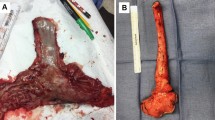Abstract
Background
Minimally invasive esophagectomy is associated with significant morbidity, which can substantially influence the hospital length of stay for patients. Anastomotic leak is the most devastating complication. Minimizing major postoperative complications can facilitate adherence to a clinical pathway protocol and can decrease hospital length of stay.
Methods
This is a retrospective study of 130 patients who underwent an elective laparoscopic and thoracoscopic Ivor Lewis esophagectomy for esophageal carcinoma between August 2014 and June 2018. A total of 112 patients (86%) underwent neoadjuvant chemoradiation. All of the 130 patients underwent a laparoscopic gastric devascularization procedure a median of 15 days prior to the esophagectomy. The target discharge date was postoperative day number 8.
Results
Thirty patients (23.08%) had postoperative complications. Atrial fibrillation (20 patients) [15.38%] was the most frequent complication. Four patients (3.1%) developed an anastomotic leak. There was one postoperative death (0.77%) in the cohort of patients. The median length of stay was 8 days. The mean length of stay for patients without complications was 8 days ± 1.2 days and 12.4 days ± 7.1 days for patients with one or more complications (p = 0.002).
Conclusion
The development of postoperative complications after minimally invasive Ivor Lewis esophagectomy significantly increases hospital length of stay. Performing the operation with a specialized tandem surgical team and including preoperative ischemic preconditioning of the stomach minimizes overall and anastomotic complications and facilitates on time hospital discharge as defined by a perioperative clinical pathway protocol.



Similar content being viewed by others
References
Pennathaur A, Gibson MK, Jobe BA et al (2013) Oesophageal carcinoma. Lancet 321:400–412
Kamangar F, Dores GM, Anderson WF (2006) Patterns of cancer incidence, mortality, and prevalence across five continents: defining priorities to reduce cancer disparities in different geographic regions of the world. J Clin Oncol 24:2137–2150
Varghese TK Jr, Wood DE, Farjah F et al (2011) Variation in esophagectomy outcomes in hospitals meeting Leapfrog volume outcome standards. Ann Thorac Surg 91:1003–1009
Rizk NP, Bach PB, Schrag D et al (2004) The impact of complications on outcomes after resection for esophageal and gastoesophageal junction carcinoma. J Am Coll Surg 198:42–50
Luketich JD, Pennathur A, Awais O et al (2012) Outcomes after minimally invasive esophagectomy: review of over 1000 patients. Ann Surg 1:95–102
Low DE, Kunz S, Schembre D et al (2007) Esophagectomy—it’s not just about mortality anymore: standardized perioperative clinical pathways improve outcomes in patients with esophageal cancer. J Gastointest Surg 11:1395–1402
Markar SR, Karthikesalingam A, Low DE (2015) Enhances recovery pathways lead to an improvement in postoperative outcomes following esophagectomy: systematic review and pooled analysis. Dis Esophagus 28:468–475
Strosberg DS, Merritt RE, Perry KA (2017) Preventing anastomotic complications: early results of laparoscopic gastric devascularization two weeks prior to minimally invasive esophagectomy. Surg Endosc 31:1371–1375
Cerfolio RJ, Bryant AS, Bass CS et al (2004) Fast tracking after Ivor Lewis esophagogastrectomy. Chest 126:1187–1194
Munitiz V, Martinez-de-Harro LF, Otiz A et al (2010) Effectiveness of written clinical pathway for enhanced recovery after transthoracic (Ivor Lewis) oesophagectomy. Br J Surg 97:714–718
Findlay JM, Tustain E, Millo J et al (2015) The effect of formalizing enhanced recovery after esophagectomy with a protocol. Dis Esopahgus 28:567–573
Prise P, Ferrari C, Cossu A, Puccetti F et al (2018) Enhanced recovery after surgery (ERAS) pathway in esopahgectomy: is a reasonable prediction of hospital stay possible? Ann Surg 270(1):77–83
Gemmill EH, Hummes DJ, Catton JA (2015) Systematic review of enchanced recovery after gastro-esophageal cancer surgery. Ann R Coll Surg Engl 97:173–179
Nguyen NT, Nguyen XMT, Reavis KM et al (2012) Minimally invasive esophagectomy with and without gastric ischemic conditioning. Surg Endosc 26:1637–1641
Perry KA, Banarjee A, Liu J et al (2013) Gastric ischemic conditioning increases neovascularization and reduces inflammation and fibrosis during gastroesophageal anastomotic healing. Surg Endosc 27:753–760
Funding
There is no industry funding for this manuscript. The authors report no proprietary or commercial interest with any product or concept in this article.
Author information
Authors and Affiliations
Corresponding author
Ethics declarations
Disclosures
Author Dr. Robert E Merritt received honoraria from Intuitive Surgical for a single-speaking engagement and CSATS for surgical video review. Author Dr. Desmond D’Souza received a honoraria from Intuitive Surgical for surgical proctoring. Authors Dr. Kyle A Perry and Dr. Peter J Kneuertz have no conflict of interest or financial ties to disclose.
Additional information
Publisher's Note
Springer Nature remains neutral with regard to jurisdictional claims in published maps and institutional affiliations.
Rights and permissions
About this article
Cite this article
Merritt, R.E., Kneuertz, P.J., D’Souza, D.M. et al. A successful clinical pathway protocol for minimally invasive esophagectomy. Surg Endosc 34, 1696–1703 (2020). https://doi.org/10.1007/s00464-019-06946-0
Received:
Accepted:
Published:
Issue Date:
DOI: https://doi.org/10.1007/s00464-019-06946-0



